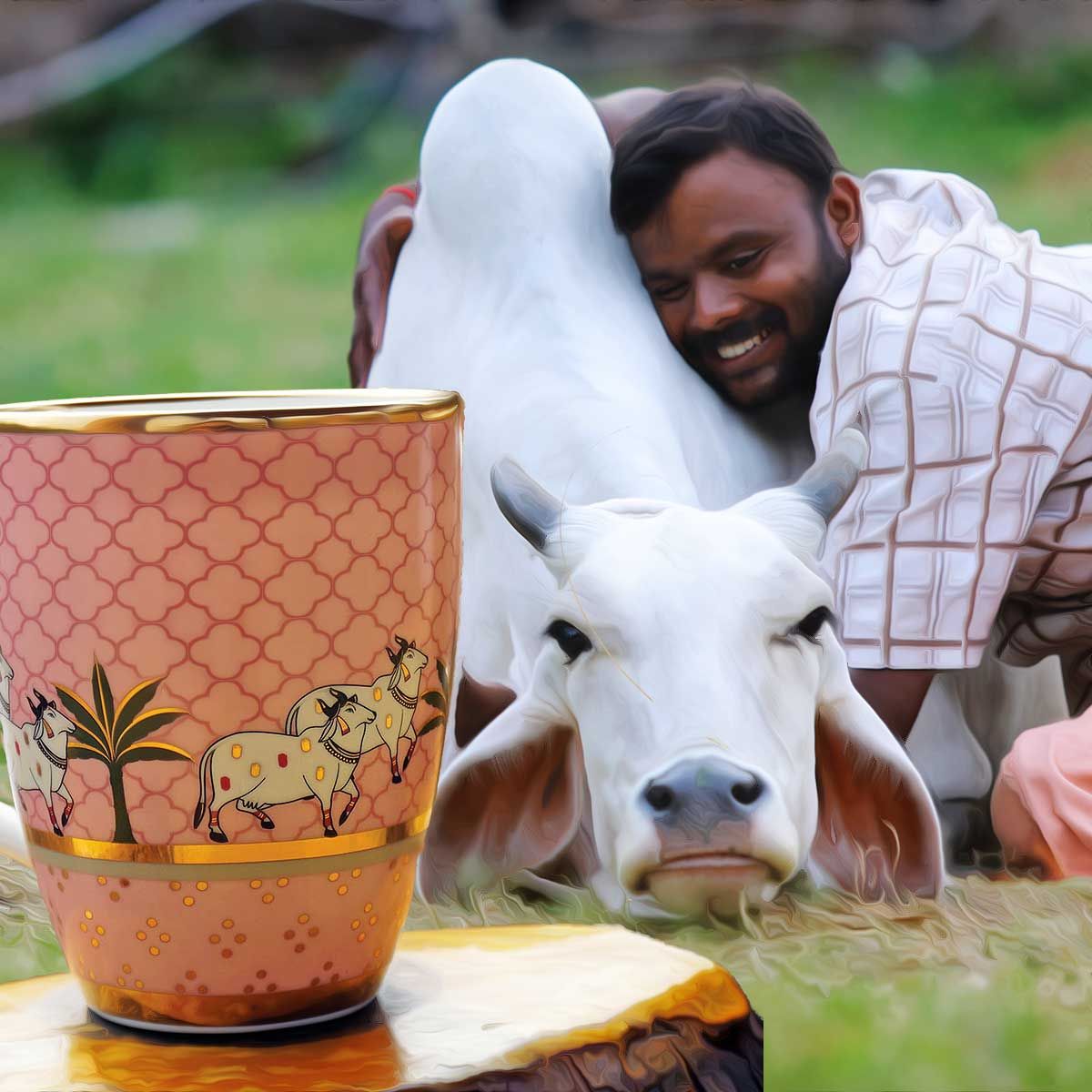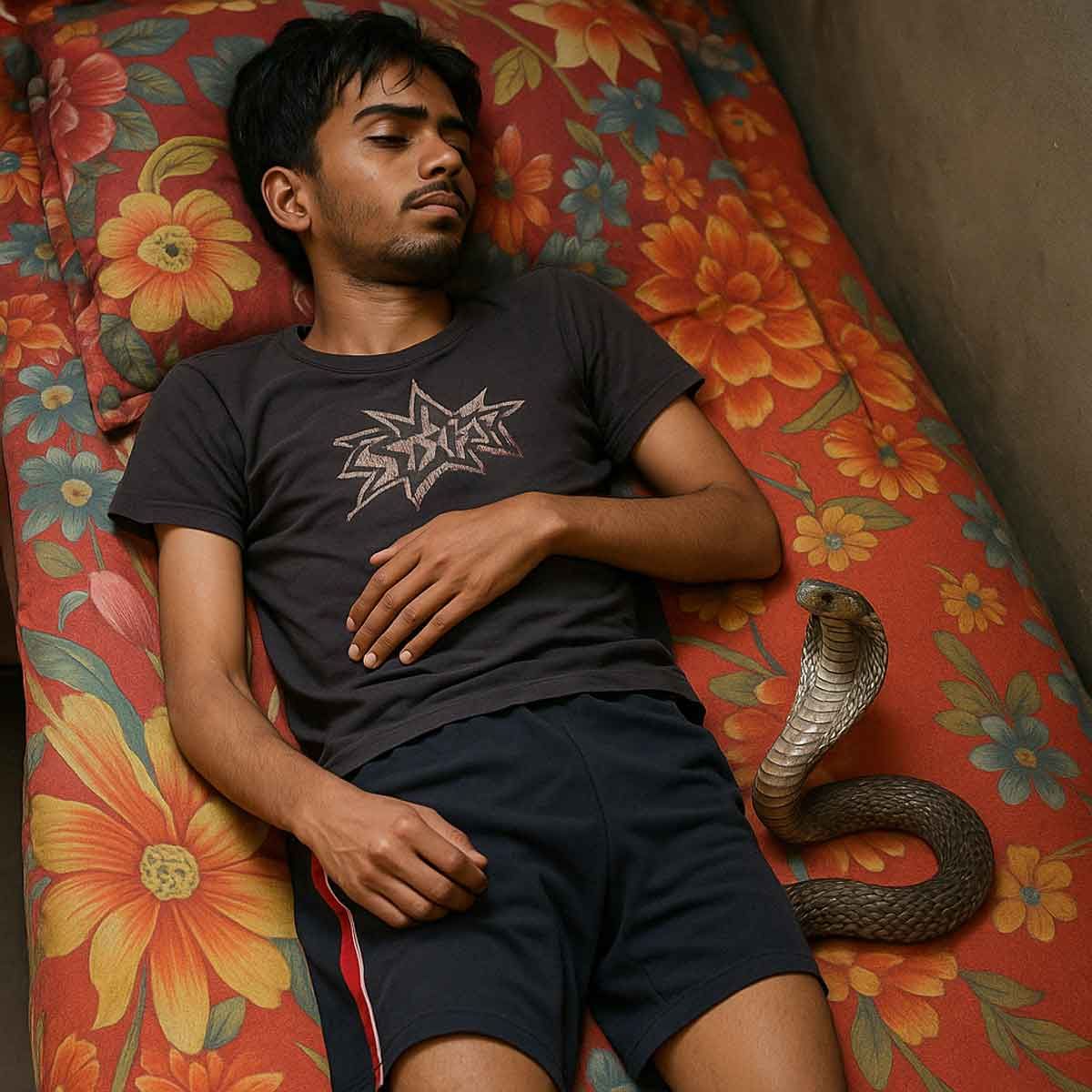More Coverage
Twitter Coverage
Satyaagrah
Written on
Satyaagrah
Written on
Satyaagrah
Written on
Satyaagrah
Written on
Satyaagrah
Written on
JOIN SATYAAGRAH SOCIAL MEDIA
"Bone China: The Untold Truth in a Name": Did you know Bone China is made from cow & ox bones? For Sanatan Dharma followers, it contradicts Ahimsa's core values, explore the surprising truth behind this popular crockery and its clash with ancient beliefs

In the bustling streets of India, where traditions stand tall and belief systems are deeply rooted, a peculiar paradox emerges. Many in India, bound by their convictions, often overlook the nuances of everyday choices. A clear example is the pervasive use of bone china, a popular yet misunderstood material.
Across the globe, the allure of bone china remains steadfast. In India, the fascination is no different. For some, it might seem like a fancy term; just another moniker without weight. For others, the specifics are a trivial concern. But when you delve into its composition, the name reveals all - bone china is made using Bone Ash, a calcined Ox bone. The irony? This very material graces the tables of many vegetarians. It's a curious sight: dedicated vegetarians sipping tea from mugs, oblivious to their bone origins, a trend that has taken hold across the country.
This story's roots trace back a few centuries, possibly even during the days of colonial yore. It was the British, particularly the sophisticated English women, who developed a penchant for the delicate sheen of Chinese porcelain. These women, pioneers of luxury and taste, shaped markets, hinting at the idea that without their refined choices, society might have remained devoid of such finery. Tracing history, the Sanskrit term 'Cheen', as referenced in epics like the Mahabharat, is likely one of the earliest mentions of China. The Chinese, believed to be the pioneers of ceramics or 'china', lent their name to this art form. However, the exact timeline of this nomenclature remains hazy, with the term 'porcelain' making its appearance much later.
With this backdrop, a simple question looms large - would you, a vegetarian, consciously eat on a bone? The answer lies in the interplay of tradition, understanding, and choice. But as we unveil the journey of bone china, the layers of its tale beg for reflection.
|
|
The artistry of the Chinese porcelain craftsmen remains unrivaled even today. Their ability to sculpt fine, gossamer-thin crockery, now dubbed "Fine China," stands as a testament to their impeccable craftsmanship. However, the name doesn't just signify the quality. Historically, it truly was a product exclusive to China, carrying a hefty price tag. Despite attempts, craftsmen elsewhere grappled to replicate the ethereal thinness and resilience characteristic of Chinese porcelain. One wonders if it's the unique techniques employed by the Chinese or the superior quality of their raw materials that bestowed them this unmatched prowess.
Transporting these treasures from China to England presented its own set of challenges. Given the era, maritime trade was the chief mode of transport. However, the fragility of porcelain meant that many pieces didn't survive the tumultuous sea voyages. Adding to the woes, a large number of vessels were requisitioned for military endeavors, narrowing the number of ships available for trade. Hefty taxes further impeded the flow of these cherished items to England. The upshot? A roaring demand with scanty supply.
Seeing a golden opportunity, English porcelain makers were galvanized into action. However, their initial attempts to mimic the revered Fine China resulted in fragile pieces that crumbled easily. The quest was clear: How to fortify their china without compromising on its elegance?
Enter Thomas Frye. In 1748, he embarked on an innovative journey, pioneering the production of what we recognize today as Bone China. His factory, the Bow China Works, nestled in East London's Bow region, conveniently sat near Essex's abattoirs and cattle markets. This proximity allowed him easy access to his unconventional ingredient - bones. Incorporating nearly 45% calcined ox bone (bone ash) into his mixture, Frye hoped to emulate the strength and finesse of Fine China. While the porcelain's quality was commendable, commercial success eluded Frye's endeavor.
The tale underscores the lengths to which artisans and entrepreneurs will go to recreate magic, even if it means turning to bones to birth beauty.
The tale of Bone China is one of innovation, persistence, and an unyielding quest for perfection. The baton of refining the bone china formula, initiated by Thomas Frye, was seamlessly taken up by Josiah Spode towards the close of the 18th century. In a marked departure from Frye’s approach, Spode opted to calcine the bone separately, rather than in tandem with the other raw materials. This method, seemingly minute in its variance, was instrumental in crafting the revered Bone China formula that has largely stood the test of time.
Breaking down the enigmatic blend: traditionally, the English concoction for bone china comprised two parts (50%) bone-ash - essentially calcined Ox bone, one part (25%) Kaolin - a mineral-rich clay often termed as china clay or white clay, and one part (25%) of Cornish stone. The latter, also known as Cornwall stone or China stone, is a distinctive medium-grained granite teeming with minerals like quartz, feldspar, and mica, and devoid of any iron-bearing minerals. It's exclusively found in a specific region of Cornwall, UK.
Spode's innovative formula wasn't his sole claim to fame. His bone china business flourished, catapulting bone china to the zenith of popularity in England. Its rapid ascent compelled other local manufacturers to delve into the realm of bone china production. For much of its history and until the late 20th century, bone china predominantly remained an English marvel. But like many iconic English commodities, bone china too embarked on a voyage to India, courtesy of the British colonizers. The exact timeline and place of the genesis of bone china in India remain shrouded in mystery, but its allure resonated with the Indian populace. One hallmark of premium bone china, as connoisseurs would attest, is its elevated bone ash content.
As we trace bone china's remarkable journey from its conception in England to its widespread acclaim in India, it stands as a testament to human ingenuity and the ceaseless pursuit of excellence.
In the intricate tapestry of ceramicware, various materials emerge with distinct characteristics. Predominantly, the trinity of Fine China, Bone China, and Clay has held sway. Modern innovations ushered in other variants like stoneware and man-made fibers like Melamine ware. But amongst them, it's bone china that often finds itself at the crossroads of aesthetic appeal and moral quandaries.
While ceramics like fine china and clay stand opaque, bone china is easily distinguishable with its translucent sheen. A simple test is to hold it against the light, and if its silhouette permeates, it's bone china. The translucent allure, however, carries with it an underlying implication – it's essentially made of bones.
A startling realization dawns upon the vast Hindu populace in India and vegetarians globally: the everyday crockery that serves their meals and brews may well be tinged with an element they religiously abstain from. In the Hindu ethos, the principle of Ahimsa or non-violence holds paramount significance. From this perspective, can bone china, in its very essence, ever be deemed pure or sanctified for consumption?
This concern isn't exclusive to Hindus. Any individual who holds reverence for life might confront an ethical conundrum. There's an undeniable morbidity to consuming from a vessel molded from the remnants of once sentient beings. Such a choice, made repetitively, could weigh on the conscience, ruminating on its karmic repercussions.
Animal enthusiasts and compassionate souls might ponder: isn't endorsing bone china akin to driving the demand for mink fur, shahtoosh, or leather products? Does beauty and elegance solely reside in ornate objects or attire? Are these luxuries indispensable like life-saving medications, or do they inadvertently sponsor an industry that contradicts one's beliefs and values?
In the final reckoning, bone china's allure is undeniable, but it’s essential to juxtapose this against the deeper ramifications of our choices, both ethical and spiritual. As consumers, the onus lies with us to evaluate if our pursuit of beauty trumps our inherent compassion and beliefs.
In the vast spectrum of choices life presents, it's often our deeply-held beliefs that guide us. The enduring principles of Sanatan Dharma or eternal order emphasize harmony with nature and all its beings. At the core of this philosophy lies the principle of righteousness and duty, guiding adherents in making morally sound decisions. This is a call to re-evaluate our choices, especially when faced with the moral implications of using bone china.
It’s simple to dismiss our individual responsibility, attributing our choices to societal norms or sentimental attachments. Yet, should we not ask ourselves: What truly holds more value — our inherited beliefs, or material possessions?
Bone china, while aesthetically pleasing, holds within it a contradiction to the principles of Sanatan Dharma. To use products crafted from the very bones of sentient beings challenges the very ethos of non-violence and reverence for life. It's imperative, then, to weigh the cultural and aesthetic allure of bone china against the profound tenets of our dharma.
Choosing the path of righteousness may require sacrifices. Material possessions come and go, but our intrinsic values define who we are. Rather than seeking validation from external sources or clinging to justifications, it’s time we heed our inner moral compass.
Let this be a clarion call to those who hold their beliefs dear. Reconsider the use of bone china. Embrace alternatives that resonate with the ethos of Sanatan Dharma. Stand firm in your convictions, leading by example, and inspire others to tread the path of righteousness.
After all, it's in our choices that our true character shines forth, reflecting the timeless values of the Sanatan Dharma. Stand tall, choose wisely, and let your actions resonate with the eternal harmony of the universe.
 Support Us
Support Us
Satyagraha was born from the heart of our land, with an undying aim to unveil the true essence of Bharat. It seeks to illuminate the hidden tales of our valiant freedom fighters and the rich chronicles that haven't yet sung their complete melody in the mainstream.
While platforms like NDTV and 'The Wire' effortlessly garner funds under the banner of safeguarding democracy, we at Satyagraha walk a different path. Our strength and resonance come from you. In this journey to weave a stronger Bharat, every little contribution amplifies our voice. Let's come together, contribute as you can, and champion the true spirit of our nation.
 |  |  |
| ICICI Bank of Satyaagrah | Razorpay Bank of Satyaagrah | PayPal Bank of Satyaagrah - For International Payments |
If all above doesn't work, then try the LINK below:
Please share the article on other platforms
DISCLAIMER: The author is solely responsible for the views expressed in this article. The author carries the responsibility for citing and/or licensing of images utilized within the text. The website also frequently uses non-commercial images for representational purposes only in line with the article. We are not responsible for the authenticity of such images. If some images have a copyright issue, we request the person/entity to contact us at This email address is being protected from spambots. You need JavaScript enabled to view it. and we will take the necessary actions to resolve the issue.
Related Articles
- PETA India’s latest wisdom – Cows are killed for beef because you are drinking milk and eating cheese
- "Animal protector or anti-Hindu organization": After seeking ban on Temple elephants, Jallikattu and Kambala buffalo race, PETA goes after Kili Josiyars - Fortune-Tellers Using Parakeets, 7 Arrested By Tamil Nadu Forest Department
- Govt imposes ban on 23 aggressive dog breeds such as Pitbulls, Rottweilers, Mastiffs, Doberman, and German Shepherds to curb attacks and protect citizens, PETA supports the initiative, aiming to prevent dog attacks and promote responsible pet ownership
- Hindus saved Sikh Gurus, provided weapons training and donated for Gurudwaras: Shattering the Hindu Vs Sikh narrative
- Insane utterances of Islamic preachers in Kerala from 'Satan entering the body if don’t chant ‘Bismi’ while having sex' to 'women having big breasts in paradise'
- China attacked India just three years after PM Nehru reduced the defence expenditure by Rs 25 crores: Union Budget 1959
- Jo Chopra, an NGO Director misled about Christmas being banned in Uttarakhand to malign Hindutva, apologizes after being called out
- Actor Urfi Javed admits that most hate she receive is from Muslims, confirms that she doesn’t believe in Islam and will never marry a Muslim man
- Why authorities ignoring conspiracy of Sexual objectification of Hindu women: #Hslut4Mstud Users on Reddit, Twitter and Tumblr are targeting Hindu women with pornographic content ‘for Muslim studs’
- Propaganda to Vilifying Hindutva by media: Gurugram protesters seeking Kalicharan Maharaj’s release dubbed as ‘Anti-Namaz brigade’
- Winning wars but losing the peace: Sri Krishna and Mahatma
- "One may reject the claims of sainthood made on Gandhi's behalf… and therefore feel that his basic aims were anti-human and reactionary", George Orwell’s Devastating Critique in his article 'Reflections on Gandhi'
- "One leak will sink a ship: and one sin will destroy a sinner": Hindus protest to stop demolition of old Shani-Hanuman temple, Kejriwal sent team to demolish a temple issuing orders by PWD Delhi in Mandawali after the complaint by Javed, Mansoor, Naushad
- "Let the punishment be equal with the offence": Arrogant Monk Amogh Lila Das banned by ISKCON due to his controversial comments on Swami Vivekananda and Ramakrishna Paramhansa, to remain secluded from public life on Govardhan hills for one month
- State-of-the-art Maharaja Bir Bikram Airport Terminal is inaugurated by Prime Minister Narendra Modi in Agartala: Follow Details to know more




























